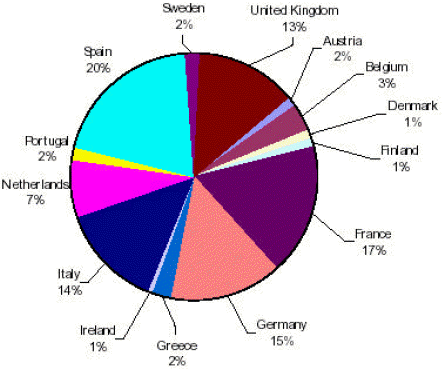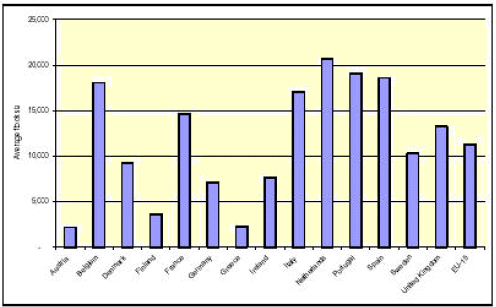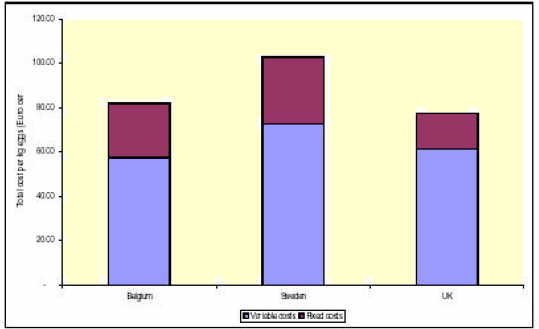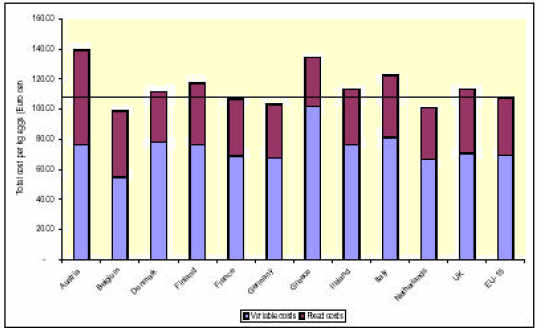



Abolition of battery cages in EU-25 : Cost estimated at €354 million
By the USDA, Foreign Agricultural Service - The EU ban on traditional cages for laying hens, which is scheduled for 2012, could cost European egg producers up to €354 million per year. An EC report calculates the cost of egg production indicating that switching to free range egg production increases cost by 20 percent and barn egg production increases cost by 12 percent.Report Highlights
The European Food Safety Authority (EFSA) also recently opined that a marked increase in bacteriological, health and welfare problems should be expected. Council Directive 1999/74/EC, which was meant to improve physiological welfare of laying hens, appears to in fact increase animal health and food safety concerns at a huge economical cost to producers.
Animal welfare for laying hens
Animal welfare in animal production has become an increasingly important concern in European agricultural politics and for the European Commission (EC). The reason for this is the unscientific perception by animal rights groups and the broader public that there is a direct link between recent years European food crises and intensive animal production. For the EU egg production sector, this resulted in Directive 1999/74/EC1, which is aimed at banning the traditional cages for egg production by 2012. This Directive leaves it up to member states (MS) to set the minimal standards for the replacement of these cages for laying hens. While the Directive was approved in 1999, two studies to assess the socioeconomic impact and the impact on food safety and animal welfare became available only recently.
Economic impact of Directive 1999/74/EC
An EC sponsored “Study on the socio-economic implications of the various systems to keep
laying hens”2, assessing the socio-economic impact of Directive 1999/74/EC and in
particular the implications of the 2012 ban on traditional caged egg production at a potential
annual loss of €315 million (EU-15) and €354 million (EU-25) for producers. The
implementation of the battery cage ban would reportedly increase egg production costs by
20 percent as a result of switching to free range production and by 12 percent for barn
production, with a smaller increase to implement the enriched cage system3.
The study
involved extensive field research in the EU-15 MS as well as in five third countries (Brazil,
India, Mexico, Ukraine and the United States). While the traditional battery cage still
accounts for 85 percent of egg production across the EU (apart from Sweden, which has
banned the use of such cages), in some MS (e.g. Austria, Denmark, Ireland, Netherlands,
Sweden and the UK) alternative non-cage systems now account for a substantial share of
output. Some MS (like Germany, UK, Netherlands and France) show a high degree of
vertical integration from producer to packer to processor. These MS generally tend to have
large production units (as do Italy and Spain) while other MS tend to have more fragmented
production units (like Austria, Greece, Ireland, Portugal).
The EU-25 produced 6.349 million tons of eggs for human consumption in 2003, an increase
of 10% since 1995, with the new MS accounting for 15 to 17 percent of EU-25 production.
The EU-25 produces just over 100 percent of its domestic egg requirements and is a
marginal net exporter of eggs. It is expected that imports will increase by 3-4 percent
when battery cages are banned.


Figure 2.9 Average flock sizes in 2000. Note: Holdings with less than 100 birds are excluded.
Source: EU farm Structure Survey (2000)
Variation in production costs between Member States
Important variations in production costs exist between MS. Key points to note are as follows:
feed per bird per day varies from 109 grams in France to 120 in Ireland and Portugal;
average annual egg collection ranges from 261 in Portugal to 293 in the Netherlands;
feed conversion ratios in efficient MS are 2.10 kg feed per kg eggs (the Netherlands) and 2.13 kg feed per kg eggs (France and Denmark) compared to 2.59 kg feed per kg eggs in Portugal and 2.41 kg feed per kg eggs in Austria and Ireland;
mortality is 4.0% in Ireland and Portugal, but reaches 7.5% in Spain and 7.0% in Italy;
larger scale producer MS such as Belgium, the Netherlands, Italy and the UK have a bird to laborer ratio of 50,000, whereas Ireland has a ratio of 10,000 and Denmark a ratio of 12,000; o the end of lay hen price is positive in some Member States, but in some MS it is a cost.

Figure 2.25: Total costs in the traditional cage system per kg eggs
Charts on EU egg production and costs of production were copied from the EC report.
Legends to the cost tables:
- dark purple sections are variable costs
- light blue sections are fixed costs
Opinion of European Food Safety Authority (EFSA) on health and welfare problems
EFSA’s Scientific Panel on Animal Health and Welfare (AHAW) recently issued an “Opinion of
the AHAW Panel related to the welfare aspects of various systems of keeping laying hens”4,
in which it signals that the removal of battery cages is likely to see an increase in
bacteriological, health and welfare problems.
Most difficult problems, e.g. insect-borne
infections, feather-pecking and cannibalism, are expected to occur in alternative and outdoor
systems, with much depending on the management of the holding itself. While this study
only focused on the food safety and animal welfare aspects of the different egg production
systems, it is obvious that the potential problems identified will come at a serious economic
cost to the producer.
Conclusion
The fact that studies on the socio-economic impact and the impact on food safety and animal
welfare of Directive 1999/74/EC were published only five years after the approval of the
Directive indicates that the potential impact of this directive was underestimated. On the
other hand, animal welfare aspects of animal farming are becoming more important, not only
in Europe but also in the United States and other parts of the world; e.g. alternative egg
production systems are also developing in the U.S., however more on a voluntary industry
basis. Therefore, the studies referenced in this report can offer a valuable benchmark.

Figure 2.26: Total costs in the enriched caged system per kg eggs

Figure 2.27: Total costs in the barn system per kg eggs

Figure 2.28: Total costs in the free range system per kg eggs
Further Information
To continue reading this report, including tables, click here
Source: USDA Foreign Agricultural Service - April 2005








